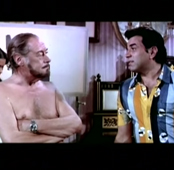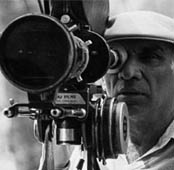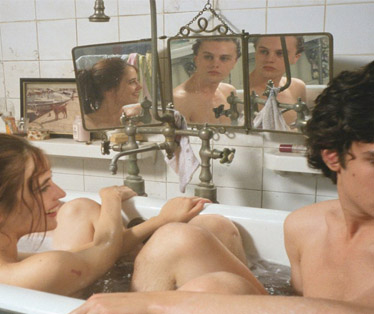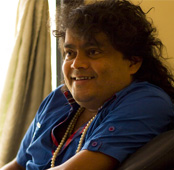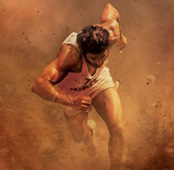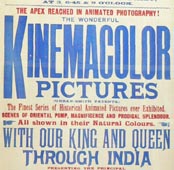Shalimar is unlike any other Indian film. Rishi Majumder revisits a non-classic.
PART I
History rewards victory, not ambition. Pyaasa, Mughal-e-Azam, Sholay, Deewar, Dilwale Dulhania Le Jayenge and, now, a Happy New Year, are likely to be celebrated decades after their release. There will be endless analysis around what made them hits or critical successes, nostalgia pieces on their 50th anniversaries, new books around their making, and interviews with ageing stars and filmmakers
Not that these aren’t useful. I would really like to know, for instance, what made Happy New Year a hit. All I have to thank the film for, after three painful hours, is that it brought back memories of Shalimar, a 1978 movie quite unlike anything Bollywood has ever seen, and a financial and critical disaster.
In a tribute to Shalimar, Happy New Year revolves around a group of people trying to steal diamonds by beating the ‘Shalimar Security System’, introduced to viewers with Shalimar’s title song—Mera Pyaar Shalimar—playing as a hat doff.
Also, the bunch of thieves in Happy New Year are described repeatedly as “losers” who’re trying to be “winners”. This is reminiscent, perhaps unintentionally, of Shalimar’s maker, Krishna Shah.
A creature of lesser Hollywood, the filmmaker has to his credit smaller genre movies (comedy and horror) such as Hard Rock Zombies, Evil Laugh, Ted & Venus and American Drive-In. A UCLA and Yale graduate, before Shalimar Shah had adapted the play The River Niger, and directed on and off Broadway theatre (one of them Rabindranath Tagore’s The Dark Chamber which won two Obies). He’d written for TV too (Six Million Dollar Man, The Flying Nun and The Man From UNCLE) and produced the animated Ramayana in 1992, and one of India’s early ‘indie’ films Hyderabad Blues.
Yet Shah never made it to the Hollwyood A list. Shalimar was his only attempt at a big blockbuster. Indian papers were full of news about him then, especially after he signed Rex Harrison. But everything was forgotten soon after the movie bombed.
The plot of the film involves four master thieves entering into a contest with one another to try and steal the “Shalimar ruby” from the biggest master thief of them all. Four master thieves and Bollywood strongman Dharmendra, who gatecrashes the competition.
It’s atrocious, but has an audacity to it that’s endearing: it features Hollywood actors like Rex Harrison, Sylvia Miles and John Saxon alongside Hindi film stars Dharmendra, Zeenat Aman and Shammi Kapoor— something no other Hindi film has done to this extent. It was released in Hindi in India and in English in the USA (as Raiders of the Sacred Stone). Both versions failed.
One really wonders what prompted Rex Harrison—Tony, Golden Globe and Oscar winner for Best Actor—after having played the iconic parts of Julius Caesar, Henry Higgins, Pope John Paul II and Dr. Dolittle, to agree to portray a Bollywood arch-villain. One imagines Harrison—now, sadly, no more, then nearing 70—would have prepared for Shalimar alongside Staircase (with Richard Burton) and Crossed Swords (with Charlton Heston). So around the same time he was essaying the considerably more complex roles of an ageing gay Londoner running a barbershop and the 16th Century Duke of Norfolk, Harrison also played Sir John Lockheed— a retired but paranoid master-thief living on an island, with many tribal slaves and Dharmendra to handle. Not that the other two movies did much better. Both were critically panned and turkeys at the box office. Harrison himself reportedly hated Staircase. It would be interesting to find out what he made of Shalimar.
Then there’s Sylvia Miles of Greenwich Village. If you ask around New York, the story you’re most likely to hear about Miles involves her throwing a plate of food on critic John Simon’s head. Simon, now 89, remembers it being steak tartare. Miles, 82, remembers “steak tartare, coleslaw, potato salad, and cold cuts.”
The provocation for this was that Simon had referred to Miles as “one of New York’s leading party girls and gate-crashers” in a review. “How could I crash anything? I was invited to everything! I was the Gwyneth Paltrow of the day,” Miles has said.
This isn’t true. Miles won two Oscar nominations for Best Supporting Actress that she received for minuscule six and eight minute appearances in the movies Midnight Cowboy and Farewell My Lovely respectively. And she had a role in Andy Warhol’s underground film Heat, a parody of Sunset Boulevard, written and directed by Paul Morissey, where she plays a has-been Hollywood starlet, seduced and used by an LA Hustler.
True to her ‘party girl’ reputation, Miles was seen at so many public events with Warhol and Morissey that ventriloquist and puppeteer Wayland Flowers remarked in one of his shows: “Sylvia Miles and Andy Warhol would attend the opening of a sewer.” Also, that Miles herself would “attend the opening of an envelope”. Flowers used his puppet, ‘Madame’, to express these thoughts, now subsumed in Manhattan lore. Clever way of sidestepping the tartare.
Miles had spoken about Shalimar to Roger Ebert, in between chewing a honey dew slice and lighting a cigarette, at a 1980 LA brunch. Interestingly, she referred to it as the film with Harrison and Saxon without mentioning any of her Indian co-stars, not even the film’s protagonist, or maybe Ebert didn’t care to report that she did. She was in her mid-forties then. She plays a trapeze artist and master thief called Countess Rasmussen. Shah establishes this with a flashback that shows Miles trapeze into a museum, wearing a bright red outfit to steal Van Gogh’s Sunflowers. Later, the Countess swings like Tarzan to access windows that seem as if they could simply have been climbed into. For the purpose of knocking out a guard, or avoiding capture, she prefers summersaulting to simple hit and runs (where Dharmendra scores).
The original choice for Miles’ role in Shalimar was Gina Lollobrigida, Italian actress, photojournalist, sculptor and sex symbol of the fifties and sixties. In The Shalimar Adventure, a forgotten 1979 book on the making of the film by publicist Bunny Reuben, a chapter titled The Battle of the Boobs reports a cleavage contest of sorts between Zeenat Aman (in her late twenties) and Lollobrigida (touching fifty at the time) at an early press conference for which the European actress had traveled to India. One doesn’t know what the import of this is. Anyhow, Lollobrigida finally walked out.
The third Shalimar actor from the Hollywood circuit, the now 79 year old John Saxon, is best remembered as Bruce Lee’s comrade-in-arms from Enter The Dragon. Saxon, born Carmine Orrico, was set to be Hollywood’s next big thing when he broke into the movies with meaty roles in Running Wild (he was 20 then) and The Unguarded Moment (21). But this was not to be, and Saxon acted, instead, in innumerable sci-fi, action and horror movies and TV shows. He was nominated for Best Supporting Actor at the Golden Globes for his portrayal of a Mexican bandit in Appaloosa. He played a similar part in Joe Kidd, co-starring with Clint Eastwood and Robert Duvall. Saxon also went on to do Italian spaghetti westerns and police thrillers.
Saxon was just past 40 when he was signed on for Shalimar, though he looks as if he is in his thirties. He plays a master thief called Colonel Columbus.
Dharmendra and Zeenat Aman, both pretty much at the top of their careers, and Shammi Kapoor, the ex-hero who had aged by then and become a prolific supporting actor, made up the Indian end of the cast. Reports say Shah had approached Amitabh Bachchan to play Dharmendra’s part, but the superstar kept delaying things still Shah gave up.
Also, Shalimar had OP Ralhan, the producer-director and sometimes actor behind big Bollywood grossers like Phool Aur Patthar and Talash. Ralhan plays a character named KPW Iyengar, alias ‘Romeo’, a master thief who has robbed the Bank of Singapore. Kapoor’s character, Dr. Dubari, is a thief who poses often as a religious figure, who has stolen St. Timothy’s precious cross from Jerusalem (like the Shalimar ruby itself, this is fictional). He cites religious writing from the faiths to justify crime. Aman plays Sir John’s (Harrison) nurse and Dharmendra’s ex flame.
Shalimar is full of bloopers and irrationalities but then such problems abound in other successful heist films of the yesteryears too, such as Topkapi or The League of Gentlemen. What really does the film in is that it’s overlong, has dully paced scenes and a plot that’s just plain boring: devoid of well-conceived twists and turns and utterly predictable.
It does have some memorable Hindi film music from RD Burman. Hum Bewafa Hargiz Na Thay by Kishore Kumar, for instance, or One, Two Cha Cha Cha—by Usha Uthup—a longish cha-cha-cha number and dance sequence that the film begins with.
There’s also Asha Bhosle’s Mera Pyar Shalimar a title-track that sounds as though it belongs to a Bond film. And like with the Bond movies it should really have been played during the opening credits. Instead, it has been used, wastefully, in sporadic bursts, in laughably futile attempts to drum up pathos or fear.
There is one well-executed sequence in the film: where Dharmendra (Spoiler Alert) paints himself in black and white to blend in with the walls and floor of the hall where the Shalimar ruby lies, as a kind of camouflage. Harrison realizes the big chequered blob inching towards his ruby is Dharmendra upon staring at a chess board with a game they’ve left unfinished. Believe it or not, it’s actually pulled off quite well.
And there is a clever reference. The fictional island, in the Indian Ocean, where the thieves meet is named Saint Dismas, the name assigned to the penitent thief crucified with Jesus Christ, as per the Gospel of Luke.
PART II
Besides these, Shalimar throws up quite a few treasures for lovers of camp. There are Hindi masala film tropes that have been used here like nowhere else. This makes for novel ‘oh-it’s-so-bad-it’s-good’ moments, as opposed to Happy New Year where, for all its eighties Bollywood references, there is mostly only the ‘it’s-so-bad-it’s-bad’. Here are some gems (Many Spoilers Ahead):
1.
Rex Harrison’s voice, in the Hindi version, is dubbed by the one and only Kader Khan— who has penned dialogues for the film as well.
Yes. The same that wrote and said:
“Dukh jab hamaari kahaani sunta hai toh khud dukh ko dukh hota hai.”
A feeble attempt at translation: When sadness hears my tale, then sadness itself feels sad.
And:
“Whiskey mein soda ya pani milane se uska taste kharaab ho jaata hai. Whiskey mein Whiskey milaake peena chahiye.”
Translation: Mixing soda or water with whiskey ruins its taste. One should mix whiskey with whiskey before drinking it.
And:
“Tumhaari yeh baat sunkar mera dil Hyderabad ke tarah aabaad ho gaya.”
Translation: Impossible.
Some perspective. A doyen of eighties Bollywood dialogue writing and delivery, Khan has played a significant part in propagating the ‘angry young man’, Hindi Cinema’s most remembered stereotype, that Salim Khan and Javed Akhtar created for Amitabh Bachchan. Ganga Jamuna Saraswati, Sharaabi, Coolie, Lawaaris, Suhaag, Muqaddar Ka Sikandar, Amar Akbar Anthony, Mr. Natwarlal, Satte Pe Satta, Hum and Agneepath are some of the famous Bachchan films Khan has written dialogue for.
As an actor, Khan was Prometheus Unbound, set in Hindi film masala. So over the top, even for an industry that routinely demanded a degree of overacting, that he made Dolby Surround seem altogether unnecessary when it came to India. Here, however, the ham extraordinaire displays remarkable restraint, almost as if he wore a horse bit for the dub. Khan’s ‘Sir John voice’ for Harrison is understated and alternates between quietly menacing to a sardonic murmur. To discover this avatar—Kader Khan The Murmurer—can be such a delight for followers of eighties Bollywood that they could watch Shalimar for this reason alone.
2.
I’m not quite sure who dubbed Sylvia Miles’ voice—or whether she did it herself—but she sounds like Helen trying to sound like an Italian trying to speak in Hindi. This is coupled with political incorrectness. In one scene she greets Ralhan with “My Idlee, Dowsaaa!” punctuated by (what else) a summersault.
3.
Two foreign master thieves communicating in Hindi is more than enough, perhaps, so Col. Columbus, John Saxon’s character, is left mute. Saxon speaks in sign language throughout the film and only Dharmendra, or S. S. Kumar, understands sign language. So he translates for others. This raises a question. Dharmendra was never meant to be on the island in the first place. He cheated his way in, taking another invitee’s place. How exactly had the master thieves planned on communicating with Columbus without Dharmendra?
In the latter half Saxon’s character acquires an added shade of complexity. He dies and because the tribals on the island feel they heard him scream after his death they dress up the dead body and worship it as their god. He still doesn’t get any dialogue though.
4.
Let’s address the question of how Dharmendra gatecrashed the gathering. One must give credit where it’s due. Shalimar is possibly the only Hindi movie where Dharmendra doesn’t fool anyone by disguising himself as a Sikh. Yes, he dons a fake beard and moustache and wears a turban, pretending to be the son of Raja Bahadur Singh— yet another master thief who was invited but, sadly, shot before he could make the trip. However, after a day of watching him conspicuously pilfer trinkets from under their eyes everyone bursts into laughter when he claims to be royalty. Why they then allow him to enter the Steal-The-Shalimar Contest, instead of sending him off to be treated for kleptomania, is a mystery. Must be the sign language.
5.
Coming back to voices, when Dharmendra says “Sir John” he sounds either as if he is saying “Mausi (Aunt)” in Sholay or “Kuttay (Dog)” in every other movie. Aman is less versatile. She addresses everyone in that sultry whine she had perfected in her time in Bollywood, a studied mix of complaint and seduction.
6.
Harrison displays so much serenity in the middle of all of this that one wonders whether he was wearing earplugs. There is mild amusement writ on his face, which may have come naturally, and a detachment that makes you suspect he was actually mentally rehearsing lines for the Duke of Norfolk.
7.
The Shalimar ruby itself is assigned an intriguing fictional history. Existing since Vedic times (whenever that may be), it was taken by Alexander and then returned to Chandragupta Maurya by Seleucus I. Then it went missing and was discovered in Srinagar’s Shalimar Gardens by the Mughals. From here it went to the Portuguese and then the English. Then it went missing again. The newspaper clipping that informs us of this is from UK’s Sunday Mirror. The headline reads: “Who Has Plucked The 100 Crore Rupee Plum?”
The “100 Crore Rupee Plum” which actually looks like a snazzy red disco ball that got cut all wrong. This makes for great tragicomedy when juxtaposed with expressions of anguish on the faces of people who die trying to procure it, to the tune of Mera Pyar Shalimar. They don’t look like they’ve lost it because of the stone. They just look mad.
8.
In the end, Dharmendra is a CBI officer. We learn of this because he tells Aman that he had squandered her life’s savings and eloped with some American girl not because he didn’t love her, but because he had to get the Shalimar ruby back for the CBI. He tells her this casually, before saying into the phone purposefully: “This is Agent 3694”.
9.
The tribals under Sir John’s command—he saved 45 of them from death so now they’re his slaves for life—are a cosmopolitan lot. Some of them resemble Africans, some East Asians, and one of them is Mudhu B. Shetty. Shetty, better known as Fight Master Shetty, or, simply, Fighter Shetty—an iconic Hindi film stuntman and action choreographer—would often appear in the action sequences he created as a dark bald hulking goon who would be beaten up by heroes half his size. Here he merely glowers in snatches, in a ridiculous outfit that makes him look like a Red Indian at a fancy dress ball. There is no explanation for this, and viewers unacquainted with the cryptic genre that is the Hindi masala movie may be at a loss as to why, in the middle of so many scenes depicting tribals in ridiculous ways, they are repeatedly confronted with shots of Shetty glaring at them angrily.
Enlightenment arrives at the climax, which comprises a fight between Dharmendra and Shetty who ambushes him—and the audience—with a sword in one hand and a spear in the other. It then dawns that the previous shots were simply Shah’s way of saying: “Here is Shetty. He may be dressed like the next enslaved tribal but wait and see.”
Not that the tribal dress code is uniform— those higher in the hierarchy wear headgear reminiscent of Greek legions while lesser ones wear single feathers. They paint their bodies, light up torches and chant “Jhingalala Hoon Hoon” while marching to nowhere in particular. This makes Dharmendra break into a song, in rhythm with this chant, about his failed relationship with Zeenat Aman.
10.
To be fair, tribals aren’t the only constituency Shalimar offends. If the movie is to be believed, erstwhile rulers of princely kingdoms committing themselves to grand larceny was a worldwide trend in the seventies. Two of five master thieves invited to try and steal the Shalimar—Countess Rasmussen and Raja Bahadur Singh—hail from nobility. And then there’s Sir John. The last government in possession of the Shalimar ruby was supposedly British. Has anyone told Queen Elizabeth II she’s being shown to have knighted someone who ran off with England’s most precious jewel?
Back to the Shalimar I & II
November 2014
 By Rishi Majumder
By Rishi Majumder
Rishi Majumder is Senior Editor at The Big Indian Picture.



